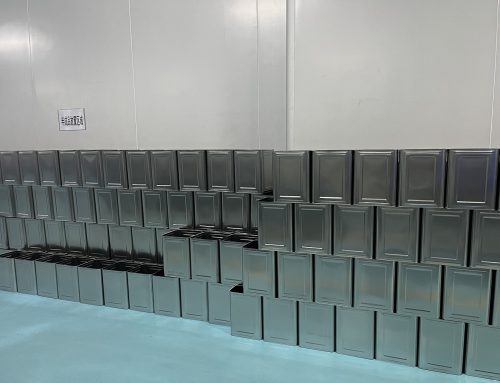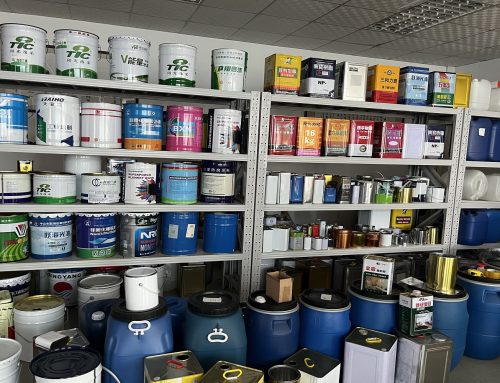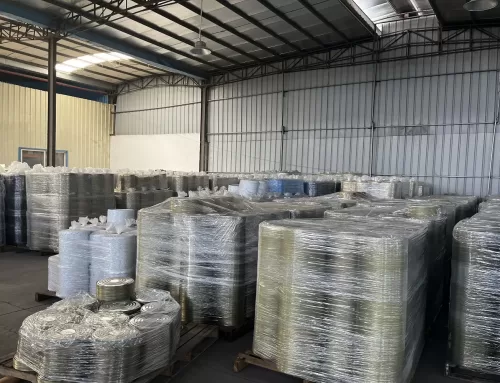Quality control of steel drum welds
1. The control of poor contact between the conductive shaft and the conductive sleeve
The working principle of the seam welder is that low voltage and high current are short-circuited through two electrodes to generate heat, and the steel plate is melted to achieve the purpose of sealing. During the welding process of the steel drum, a large current of about 16000A will be transmitted from the transformer to the welding wheel through the movable contact surface. Due to the restriction of the resistance and hardness of the material, we cannot use heat-treated steel as the conductive shaft in order to increase the hardness. It is used with the conductive sleeve to increase the wear resistance, so only the heat-treated chromium zirconium copper material can be selected as the conductive shaft, and red copper or 94 copper is used as the conductive sleeve.
Although the above two materials are used as the movable contact conductor, the electrical conductivity is improved, but the wear resistance is relatively poor, especially the hardness difference between the two materials is small, which is easy to cause the joint surface to be scratched or even killed by fire. When the above situation occurs on the contact surface with the conductive sleeve, it is easy to cause heating of the contact surface, and cause the current instability of the seam welder during welding, and the leakage of the weld seam occurs. Therefore, the seam welding machine must use chromium zirconium copper with a relatively high softening temperature and hardness as the conductive shaft, so that it is not easy to cause hair pulling and other phenomena. At the same time, the operator should refuel between the conductive shaft and the conductive sleeve frequently. When the conductive shaft and the conductive sleeve are found to be seriously worn, they should be replaced in time to ensure the stability of the welding current, so as to avoid the change of the set current parameters due to the poor contact between the shaft and the sleeve. cause weld leakage.
2. Poor control of the contact surface of each conductor in the electrode circuit
During the production process of steel drums, the surface of the seam welder seems to be welded normally, and the network voltage, controller, and welded steel plates are also normal. However, serious cracking and leakage often occur in the process of flanging and leak testing of steel drums. It is very likely that in the electrode circuit of the seam welding machine, a certain conductor connection part will contact due to oxidation, ignition, screw loosening, etc. bad. At this time, the direct short-circuit method can be used. When the cooling water is normally flowing, the normal welding current is directly short-circuited. After about ten minutes, it is found that the part is particularly hot, indicating that there must be a problem with the contact surface of this part. Disassemble for correction.
3. Control of uneven welding speed of seam welding machine
During the welding process of the seam welding machine, due to the non-standard production of the feeding frame, the positioning wheel, clamping wheel, and internal and external material frames of the spot-free seam welding machine and automatic seam welding machine are adjusted too tightly, or the guide groove and other parts are not properly positioned. , so that the resistance of the steel drum is large or small during the welding process, resulting in uneven speed, so that under the same specification, the heat will fluctuate, and there will be unstable phenomena such as weld leakage and cracking. At this time, we need to check the hidden parts of the seam welding machine that may cause uneven speed in time, and eliminate them in time.
4. Control of welding pressure
The seam welding machine is a kind of resistance welding machine. It uses pressure on the workpiece and directly short-circuits the metal to achieve the purpose of welding. When the welding current is the same, the welding pressure is different between the two layers of steel plates. The difference in resistance between them produces different heat. The greater the pressure, the smaller the resistance between the steel plates, and vice versa. Therefore, maintaining the consistency of the welding pressure is directly related to the stability of the welding current and the quality of the welding. Therefore, under normal production conditions, the constancy of the welding pressure must be well controlled. When we select the welding pressure, how much pressure should be used for the thickness of the steel plate, the process standard should be formulated and the operation should be standardized.
5. Material and hardness control of welding wheel
During the welding process of the seam welder, the steel plate is subjected to a certain pressure between the two welding wheels, and is heated and melted by a large current, so the requirements for the welding wheel are relatively high. At present, there are copper-tungsten alloy, cobalt-cobalt copper, and chromium-zirconium-copper as materials for welding wheels. In order to improve the utilization rate of the welding wheel, it is best to use copper-tungsten alloy with high hardness and cobalt-cobalt copper, but these two materials are very expensive. There are also manufacturers who trial-produce nickel-chromium-copper as a welding wheel, but these materials have a low softening temperature, are prone to brittleness, and also adhere to the steel plate. Therefore, chromium zirconium copper is still the most economical choice as a welding wheel at present, but the heat treatment hardness of chromium zirconium must reach the national standard HRB75o or above to ensure the durability, economy and welding quality of the welding wheel. At the same time, during welding, the iron slag and garbage on the surface of the welding wheel must be removed to avoid changes in welding current.
6. Control of the lap width of the steel plate
The welding seam of the cross-cut seam welder seems to be fully welded on the surface, but it is not. The melted part of the weld is composed of two regions: the melt and the nucleation. Near the two sides of the bluing area, due to the influence of the current flow and the heat dissipation degree of the welding seam protection side, the two sides of the welding seam are not necessarily completely welded, and only the middle nucleated part is the real weld. Therefore, there is such a regulation in the welding process. The lap width of the weld is the addition of the thickness of the two layers of steel plates and the coefficient of 1.7. 1, 2 mm + 1, 2 mm + 1, 7 coefficients are equal to 4, 1 mm. We can understand that the thickness of 1, 2+1, 2 mm is equivalent to the width of the nuclei, the coefficients of 1 and 7 are equivalent to the solution, and the minimum nuclei cannot be smaller than the width of the two-layer thickness of the steel plate. If the lap is too small, it is easy to crack in subsequent processes such as rib expansion, rounding, flanging, etc. Therefore, a certain lap width must be controlled to ensure the welding quality, and the smaller the lap, the better. Of course, there are too many laps, which not only costs materials, but also costs electricity, and it is also not good for the use of seam welding machines. In actual production, steel plates with a thickness of less than 0.8 mm, especially galvanized plates, may wear off part of the steel plate body by grinding the zinc layer, so the width of the lap should be appropriately increased.
7. Control of the blanking size of the steel plate
In the seam welding process of the seam welding machine, the control of the blanking of the steel plate has a considerable relationship with the quality of the weld. Especially when using spot-free seam welding machine and automatic seam welding machine, if there is too much error in the length of the blanking material, it will cause the resistance of the steel plate to change when it passes through the welding wheel, resulting in the speed change of the steel drum during the welding process, causing the heat to change. stable. If the error of the blanking diagonal distance is too large, the width of the lap will vary, and it will also cause changes in the welding heat and even the scrapping of the barrel. Therefore, the length and diagonal distance of the steel plate must be controlled when cutting.
8. Selection and control of steel plate material.
At present, the steel plates supplied on the market mainly include SPCC ST12 and other grades. With this experience, many steel drum manufacturers encounter the same brand, the same batch, and even the same coil of steel with different quality. The same seam welding machine is the same welding specification, the leakage rate of the product is different, so to control the quality of the welding seam, it is necessary to choose a steel plate with a low price and a low product rate as the preferred material.
9. Quality control of uneven grinding during welding of galvanized sheet
During the welding process of steel drums, the uneven thickness of the material has a great influence on the change of welding heat. After the operator selects a certain welding specification, the thickness of the galvanized material is uneven during the grinding process or the zinc layer is not completely ground. Therefore, when grinding galvanized sheet, it is best to use machinery and less manual grinding, and it is necessary to adjust the amount and uniformity of grinding wheel grinding to prevent uneven thickness or beveled edges. .
10. Unstable control of weldment displacement
During the welding process of the steel drum, in addition to the speed and pressure control, the stability of the workpiece movement is also very important. Due to mechanical reasons, the workpiece twists left and right, up and down, and it is very likely that there will be leakage of the steel drum in a certain part. , and always in one position, it is necessary to observe and check whether the workpiece is twisted during the welding process.
11. Adjustment control used by the controller
At present, the controllers used by seam welding machine manufacturers include ordinary microcomputer controllers, variable frequency controllers, intermediate frequency controllers, and three-phase secondary rectifier controllers. The quality of these controllers should be relatively stable at present, but they are selected in welding specifications. There is a certain emphasis on adjustment. When selecting specifications, it is recommended to use small current adjustment, small batch trial welding of steel drums, especially when using spot-free welding machine and automatic seam welding, welding one inspection and one isotonic. After the leakage and cracking are basically stable, large-scale welding can be performed to prevent batches of repairs or even scrapping of steel drums.
In addition, after the welding current is adjusted, if the welding speed or welding pressure is changed, the welding current should be properly adjusted to avoid cracking and leakage of the welded steel drum.
12. Water temperature and water quality control of cooling water
In the welding process, the seam welder is equivalent to a high-power electric furnace. Such a large amount of electrical energy is converted into heat energy, and it needs to be cooled with cooling water to take away the heat. If the cooling effect is not good, the temperature of the whole electrode circuit of the seam welding machine is getting higher and higher. As we all know, metal materials have a characteristic, the higher the temperature, the greater the resistance, the lower the conductivity, we have found this situation in a few customers. The welding started normally, but after a period of time, there was a batch leakage phenomenon. In fact, this is due to the continuous increase of the water temperature and the continuous decrease of the welding heat, which caused the instability of the product quality. Therefore, the cooling of the circulating use Water must be equipped with effective water cooling equipment such as cooling towers. In addition, the water quality of the cooling water should be well controlled, and no garbage and impurities should enter the cooling water circuit of the seam welding machine, so as not to block the pipeline, reduce the cooling effect, or even burn out other components such as transformers, causing unnecessary trouble.
13. Control of network voltage stability
The grid voltage is rated at 380V, but the actual grid is generally slightly higher than this standard. Due to the difference in the size of the network load, there are cases where the network voltage is lower than 380V. When the network voltage drop is greater than 10%, seam welding will occur. The heat adjustment range of the machine is very small. If the current is slightly increased, the workpiece will break down. If the current is slightly increased, the workpiece will leak and crack, and the weld will be unsightly. There is another situation, due to the small capacity of the distribution transformer, when other high-power electrical appliances are turned on, the network voltage fluctuates up and down. This phenomenon is the most taboo for welds. When the voltage suddenly drops or rises during normal welding, this weld will leak. In addition, the distribution transformer is too far away from the seam welding machine. Therefore, when these problems occur, the quality of the network must be improved. First, increase the capacity of the network transformer; second, avoid the cross-use of high-power electrical appliances; It is best to use copper core cables. There is also the use of an intermediate frequency seam welder or a seam welder with a variable frequency controller to reduce the load on the network.
2. Troubleshooting of seam welding machine
1. The air switch trips, and the welding wheel is directly short-circuited, causing fire and smoke.
Generally, it is a short circuit between layers of the transformer or the primary and secondary breakdown. Remedy: disconnect the transformer to connect the cable and check it with a multimeter.
2. The controller displays an alarm and does not work. It may be that the controller lacks water or the water pressure is too low, or it may be that the seam welder is overcurrent, undercurrent, overvoltage, or undervoltage. Remedy: Check whether the cooling water pressure and water flow are normal, and whether the heat adjustment is reasonable.
3. The transformer vibrates, the air switch trips, and the workpiece breaks down.
It may be that the thyristor single tube is turned on or all the tube cores are turned on. Remedy: replace the thyristor.
4. After starting the welding switch of the seam welding machine, the welding wheel cannot come down.
It may be that the solenoid valve has not received the controller signal, the solenoid valve spool is stuck and cannot be reversed, and the solenoid valve coil has been burned out. Remedy: Check whether there is a current signal in the connection line of the solenoid valve, if there is no signal, overhaul the controller, manually press the solenoid valve to reverse the direction, if there is no action, replace the solenoid valve.
5. The welding wheel does not rotate after pressing the workpiece.
Elimination method: check whether the controller has motor control signal, whether the relay controlling the motor is active, whether the motor is burnt out, whether the speed control inverter is faulty, whether the pin of the transmission shaft falls off and breaks, and whether the electrode shaft and the tile are bitten. . Check and deal with them one by one.
6. There is no welding current after the welding wheel comes down.
Troubleshooting method: Check whether the controller has welding signal output, whether the water pressure switch fails to open, and check and repair one by one.
7. When the welding wheel comes down, fire:
It is possible that the pressurization time is too short, the air source pressure supply cannot keep up, the welding pressure is adjusted too small, and the cylinder piston sealing ring is seriously worn, causing the upper and lower air chambers to be inflated.
Elimination method: prolong the welding pressurization time, increase the air source pressure or configure the air storage bag, and replace the cylinder sealing ring.
8. The welding seam is not clear.
Elimination method: Check whether there is burr, iron ballast, unevenness on the surface of the welding wheel or whether the tooth tip of the correction wheel is worn, and the working current is adjusted too large. Remedy: Grind the welding wheel, replace the correction wheel, properly adjust the welding current, and check whether the grid voltage drop is too large.
9. The head and tail of the weld are cracked.
Elimination method: There are two phenomena: one is that the current is too large to tear; the other is that the current is too small to crack, if the tear is to reduce the current, if the crack is to increase the current.
10. The width of the blue area is inconsistent.
Elimination method: Carefully observe the width of the blue area. The irregularity may be that the contact surface of a conductor part of the secondary circuit is not good. The width of the blue area changes regularly, and there may be a problem with the main control board of the controller. Solution: Check the connection point of the secondary circuit. Repair the controller.
11. The welding wheel is dislocated.
Elimination method: It may be that the wear of the conductive sleeve is too large, and the conductive shaft and the conductive sleeve are replaced.




